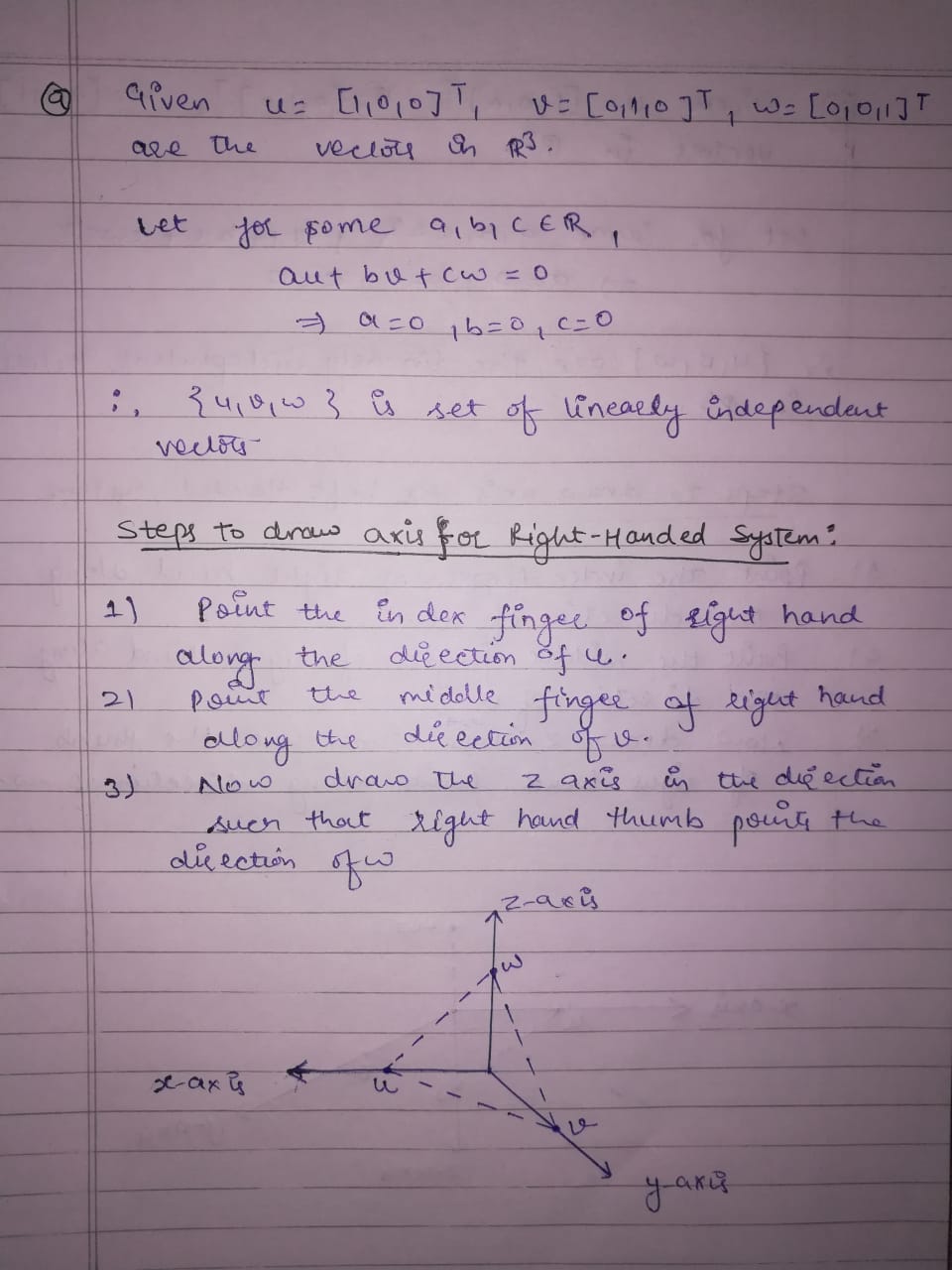Draw a set of r, y, and z axes so that the vectors ([1,0,0], [0,1,0, [0,0, 1T) form a right-handed system. Draw a set of x, y, and z axes so that the vectors ([1,0,0], [0, 1, 0], [0,0, 1]T) form a left-handed system.
Draw a set of r, y, and z axes so that the vectors ([1,0,0], [0,1,0, [0,0, 1T) form a right-handed system. Draw a set of x, y, and z axes so that the vectors ([1,0,0], [0, 1, 0], [0,0, 1]T) form a left-handed system.
Advanced Engineering Mathematics
10th Edition
ISBN:9780470458365
Author:Erwin Kreyszig
Publisher:Erwin Kreyszig
Chapter2: Second-order Linear Odes
Section: Chapter Questions
Problem 1RQ
Related questions
Question
Please do part A and B and please show step by step and explain
![(a) Draw a set of \( x, y, \) and \( z \) axes so that the vectors \([1, 0, 0]^T, [0, 1, 0]^T, [0, 0, 1]^T\) form a right-handed system.
(b) Draw a set of \( x, y, \) and \( z \) axes so that the vectors \([1, 0, 0]^T, [0, 1, 0]^T, [0, 0, 1]^T\) form a left-handed system.](/v2/_next/image?url=https%3A%2F%2Fcontent.bartleby.com%2Fqna-images%2Fquestion%2F892e817a-9b32-4eeb-b8fc-5dd7ffde6479%2Fde40621c-3248-4d16-8d56-4e099fdb9551%2Fpoylg69_processed.png&w=3840&q=75)
Transcribed Image Text:(a) Draw a set of \( x, y, \) and \( z \) axes so that the vectors \([1, 0, 0]^T, [0, 1, 0]^T, [0, 0, 1]^T\) form a right-handed system.
(b) Draw a set of \( x, y, \) and \( z \) axes so that the vectors \([1, 0, 0]^T, [0, 1, 0]^T, [0, 0, 1]^T\) form a left-handed system.
![Any \(3 \times 3\) matrix \(A\) produces a function from three-dimensional space to itself as follows: given any vector \(\mathbf{v} = [v_1, v_2, v_3]^T\), then the image vector is \(A\mathbf{v}\). Using summation notation, we may write:
\[
[A\mathbf{v}]_i = \sum_j A_{ij}v_j.
\]
Now, whenever we move an object in space, to get the new locations of various points on the object we have to define a function whose domain and codomain are subsets of \(\mathbb{R}^3\). If that object is a rigid sphere (like the earth), and the motion is such that the center of the sphere does not change, the motion is called a rotation. The function that describes a rotation in \(\mathbb{R}^3\) can actually be expressed as a matrix as described above. But not all \(3 \times 3\) matrices are rotation matrices. They must have some particular mathematical properties, as described in the next two paragraphs.
First, a rotation matrix \(R\) must preserve lengths and angles. In other words, if \(\mathbf{v}\) and \(\mathbf{w}\) are any two 3-d vectors , then \(\|R\mathbf{v}\| = \|\mathbf{v}\|\), \(\|R\mathbf{w}\| = \|\mathbf{w}\|\), and furthermore the angle between \(R\mathbf{v}\) and \(R\mathbf{w}\) must be the same as the angle between \(\mathbf{v}\) and \(\mathbf{w}\). In view of the cosine formula, this means that the dot product must be preserved: \(R\mathbf{v} \cdot R\mathbf{w} = \mathbf{v} \cdot \mathbf{w}\). In fact, since vector length is the square root of a dot product, all of these conditions will be satisfied as long as
\[
R\mathbf{v} = \mathbf{v} \cdot \mathbf{w}
\]
for any two 3-d vectors \(\mathbf{v}\) and \(\mathbf{w}\).
Another important property of rotation matrices is that they preserve handedness. Handed](/v2/_next/image?url=https%3A%2F%2Fcontent.bartleby.com%2Fqna-images%2Fquestion%2F892e817a-9b32-4eeb-b8fc-5dd7ffde6479%2Fde40621c-3248-4d16-8d56-4e099fdb9551%2F0nttpxa_processed.png&w=3840&q=75)
Transcribed Image Text:Any \(3 \times 3\) matrix \(A\) produces a function from three-dimensional space to itself as follows: given any vector \(\mathbf{v} = [v_1, v_2, v_3]^T\), then the image vector is \(A\mathbf{v}\). Using summation notation, we may write:
\[
[A\mathbf{v}]_i = \sum_j A_{ij}v_j.
\]
Now, whenever we move an object in space, to get the new locations of various points on the object we have to define a function whose domain and codomain are subsets of \(\mathbb{R}^3\). If that object is a rigid sphere (like the earth), and the motion is such that the center of the sphere does not change, the motion is called a rotation. The function that describes a rotation in \(\mathbb{R}^3\) can actually be expressed as a matrix as described above. But not all \(3 \times 3\) matrices are rotation matrices. They must have some particular mathematical properties, as described in the next two paragraphs.
First, a rotation matrix \(R\) must preserve lengths and angles. In other words, if \(\mathbf{v}\) and \(\mathbf{w}\) are any two 3-d vectors , then \(\|R\mathbf{v}\| = \|\mathbf{v}\|\), \(\|R\mathbf{w}\| = \|\mathbf{w}\|\), and furthermore the angle between \(R\mathbf{v}\) and \(R\mathbf{w}\) must be the same as the angle between \(\mathbf{v}\) and \(\mathbf{w}\). In view of the cosine formula, this means that the dot product must be preserved: \(R\mathbf{v} \cdot R\mathbf{w} = \mathbf{v} \cdot \mathbf{w}\). In fact, since vector length is the square root of a dot product, all of these conditions will be satisfied as long as
\[
R\mathbf{v} = \mathbf{v} \cdot \mathbf{w}
\]
for any two 3-d vectors \(\mathbf{v}\) and \(\mathbf{w}\).
Another important property of rotation matrices is that they preserve handedness. Handed
Expert Solution
Step 1

Step by step
Solved in 2 steps with 2 images

Recommended textbooks for you

Advanced Engineering Mathematics
Advanced Math
ISBN:
9780470458365
Author:
Erwin Kreyszig
Publisher:
Wiley, John & Sons, Incorporated

Numerical Methods for Engineers
Advanced Math
ISBN:
9780073397924
Author:
Steven C. Chapra Dr., Raymond P. Canale
Publisher:
McGraw-Hill Education

Introductory Mathematics for Engineering Applicat…
Advanced Math
ISBN:
9781118141809
Author:
Nathan Klingbeil
Publisher:
WILEY

Advanced Engineering Mathematics
Advanced Math
ISBN:
9780470458365
Author:
Erwin Kreyszig
Publisher:
Wiley, John & Sons, Incorporated

Numerical Methods for Engineers
Advanced Math
ISBN:
9780073397924
Author:
Steven C. Chapra Dr., Raymond P. Canale
Publisher:
McGraw-Hill Education

Introductory Mathematics for Engineering Applicat…
Advanced Math
ISBN:
9781118141809
Author:
Nathan Klingbeil
Publisher:
WILEY

Mathematics For Machine Technology
Advanced Math
ISBN:
9781337798310
Author:
Peterson, John.
Publisher:
Cengage Learning,

